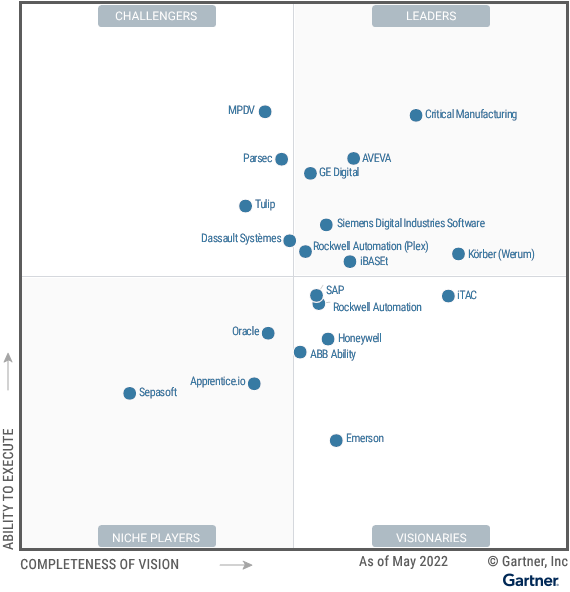Last year ACE posted our first blog about the Gartner “MES Magic Quadrants for 2021.” This is a report on the state of vendors who provide MES solutions. The quadrants are formed by a matrix of “completeness of vision” and “Ability to execute.” The key takeaway from our article last year was that many of the leading MES providers were able to rank as highly as they did in their ability to execute because they leverage the expertise of system integrators to execute projects.
As we look at this year’s report, it spends a lot of ink covering the state of mergers and acquisitions creating a new landscape. These mergers dramatically affect the product suite the involved vender offers. As such less focus was placed on actual execution and more was spent on whether the new combined organization can provide a fuller offering.
 Figure 1. The complete rankings for the Gartner Magic Quadrant for MES.
Figure 1. The complete rankings for the Gartner Magic Quadrant for MES.
Last year, the highest rated MES vendor in execution was Parsec, rated a leader. Two strengths identified by Gartner were that they used an extensive network of integrators, and that it had global reach. Furthermore, Parsec has solutions for continuous, batch, and discrete manufacturing customers, giving them a breadth and depth of geographically diverse offerings. This is just an example of how Gartner approached the “ability to execute” last year.
This year, the highest-rated MES vendor in execution was Critical manufacturing. Similarly to Parsec last year, independent SI’s were identified as important. That said, a caution specifically identified was Critical Manufacturing’s shortage of North American implementations. Additional cautions include a difficulty to migrate to the latest versions, and resource shortages for their IIOT platform.
It’s clear from the above examples that Gartner’s “ability to execute” has changed over the last year. While the exact algorithms are not published, Gartner does a reasonably good job of explaining how they evaluated each vendor. The two most important areas are “Product or Service” and “Customer Experience.” Gartner defines these as “Core goods and services” and “the ways customers receive technical support.” While these are obviously both very important, they do not perfectly align with the common notion of a vendor’s ability to execute on a MES solution. The third component is the actual implementation. While this implementation approach is definitely included in the evaluation, it is far from clear that the highest scoring “ability to execute” MES vendor has the best approach for executing a project.
This is a transition year for most of the vendors in the report. Whether it’s by adding additional internal support teams such as Parsec has done, or incorporating new acquisitions into their offering, like Rockwell, the support structures are everchanging. It makes sense that this would impact how Gartner covers each MES vendor. For end-users looking to evaluate a strategic partnership with an MES vendor, the actual implementation is of critical importance. And it seems to this author that something so important ought not be buried.
Learn more about our approach to MES and our established relationships with our technology partners.

 Figure 1. The complete rankings for the Gartner Magic Quadrant for MES.
Figure 1. The complete rankings for the Gartner Magic Quadrant for MES.